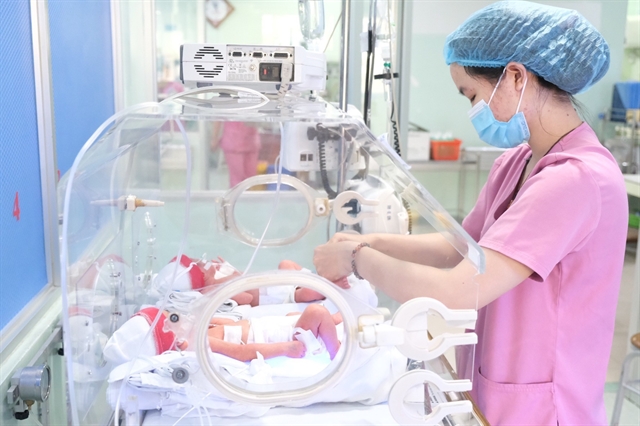 Society
Society


|
| Twins delivered prematurely by a woman in HCM City’s District 12 who contracted COVID-19 being treated at Hùng Vương Hospital. Worried vaccines would affect the children in her womb, she skipped vaccination. Photo Courtesy of the hospital |
HCM CITY— HCM City should pay attention to new COVID-19 variants and strengthen testing in high-risk areas such as traditional markets and malls, Deputy Prime Minister Vũ Đức Đam told a meeting with city authorities on Thursday.
They needed to enhance medical surveillance of all people including children aged below 12 and seniors, those with underlying medical conditions and others who have not been vaccinated due to contraindications, he said.
Every health station and task force in wards, communes and towns should visit COVID patients being treated at home regularly, he said.
The city should strengthen communication about safety measures to encourage members of the public to call medical workers to get timely tests and treatment instead of hiding when they contract the disease, he said.
The guidance related to tests and preventive measures in industrial parks should be updated regularly to prevent disruption of the functioning of enterprises whose workers have contracted COVID, he said.
He instructed the city to get private health establishments to co-operate with mobile medical stations to treat patients at home, and have policies to pay for treatment costs just like at public hospitals.
Any additional charges for treatment should be published for the public to know, he said.
The Department of Health should ensure there are enough stocks of medicines to treat patients and oxygen cylinders, and online health examination should be strengthened, he said.
According to the city Steering Committee for COVID-19 Prevention and Control, 10 districts and Thủ Đức City are at “low risk” of COVID, 11 others are at “medium risk” and Cần Giờ is at “high risk”.
Củ Chi, 11 and Gò Vấp districts and Thủ Đức City have this week seen the level increase from low to medium.
In Củ Chi, the patients are all factory workers, and the district has worked with the management of industrial parks and export processing zones as well as enterprises to support quarantine and treatment of infected people.
It has speeded up the second vaccine shots for people aged more than 18, while almost all children aged 12-18 have got the first.
Gò Vấp continues to strengthen monitoring and treatment of patients at home and hospital, screening people living in high-risk areas and vaccination.
It has quarantine facilities in all its wards besides mobile medical stations to take care of patients.
It has also brought in private healthcare establishments and other organisations and volunteers to help with treatment.
Tăng Chí Thượng, head of the city Department of Health, said task forces had been set up to localise and prevent spread.
There are 264 mobile medical stations, each capable of taking care of at least 50-100 patients at home. More than 292,000 packs of medicines have been distributed to health centres across the city.
As of November 16 the city has administered nearly 13.9 million doses of vaccines, including 668,000 to children aged 12-17.
Two days after reopening bars, karaoke and massage parlours and spas the city People’s Committee decided to shut them down again on November 18 as the disease continues to pose a threat.
Speaking to the media on Thursday, Phạm Đức Hải, deputy head of the city Steering Committee for COVID-19 Prevention and Control, explained this by saying the city prioritises safety and these would only reopen when safety is ensured.
The number of new cases in the city has been 1,000-1,400 a day in recent days, with the number of severe cases still high and increasing as are the number of fatalities, he said.
But the department said there are more than 9,100 doctors and 19,600 nurses, sufficient to cope with the increasing numbers. VNS